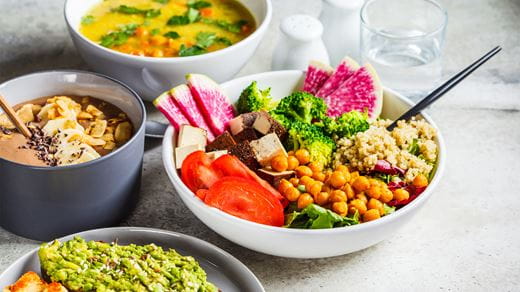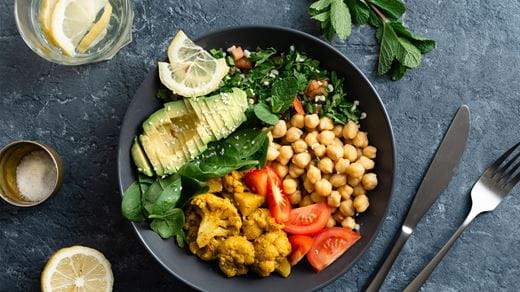Written by: Nicole Osinga, RD
In my practice, I often get clients who are interested and excited about trying plant-based eating. After all, a plant-based diet is fibrous, nutrient-rich and, according to scientific studies, linked to many benefits – ranging from better weight management to the reduced risk of heart disease, diabetes, and certain cancers, including breast, prostate, colorectal and gastrointestinal cancers.1
When someone is new to plant-based eating, my approach is to help them make realistic and sustainable changes. It might not be easy for someone who has never tried foods made with legumes, tofu, or plant-based milk to dive fork-first into plant-based meals the day after making this decision. However, people might also not need to transform their diet to be completely 100% plant-based. Maybe just a tip towards the direction of adding more plant-based foods into their everyday eating choices will provide them with enough satisfaction and benefit.
Below are some tips to help you counsel a client who is interested in, but new to, plant-based eating:
- Try Meatless Mondays
One of my favourite tips to suggest is starting with a Meatless Monday. This involves committing to at least one meatless dinner a week for themselves and their family. My clients often surprise me with how quickly other dinners during the week turn into meatless meals after this one change!
- “Veganize” Meals You Already Love
Already love tacos? Try a black bean taco! How about a meaty pasta sauce? Use lentils in place of the meat! Have your client work with the types of meals they already love and make a few subtle changes by swapping in a meatless alternative.

- Experiment With Plant-Based Protein Alternatives to Meat
Instead of focusing on what to take away from a meal, focus on what can be added. Plan meals that include at least one plant-based protein to replace the meat protein to make a meatless meal. Plant proteins can come from beans, legumes, nuts, seeds, quinoa, leafy green vegetables, or whole grains. Here are some suggestions:
• Chickpeas
• Lentils
• Tofu/Tempeh
• Legume Pasta
• Edamame
One serving (1 cup of beans/edamame/ legume pasta or 6 oz of tofu/tempeh) of each of these foods contain 15-20 grams of protein.2 Adding more plant-based proteins is a part of a healthy, balanced diet and an easy way to explore more meatless options with your meals.

- Increase Those Plant-Based Fats
I have clients who are surprised to learn that some alternative cheese products are made from nuts, like cashews, and plant-based oils, like sustainable coconut oil. Plant-based spreads are great alternatives to butter, which you can try incorporating into a favourite dish along with various nuts, seeds, avocados, and olives – they will help you feel fuller after a meal and add some great flavour as well.
- Help Them Remember Their ‘Why’
It’s not easy to change a diet. My clients have run into a few hurdles – including not liking some of the new foods that they try, feeling different after eating those new foods, dealing with negative feedback from family members, among others. My advice during this transition is to have them remember their “why.” I tell them to capture their “why” with words, images or pictures left on sticky notes, dropped into the notes on their phone or posted wherever they look for inspiration and encouragement every day. If they remember their “why” for why they want to change their diet, especially in a way that can help reduce their risk of cardiovascular disease, this could keep them motivated and on track to adopting a plant-based diet.
To support you in counseling your patients through their transition to a more plant-based diet, download my guide on plant-based sources and their nutrient data. I hope this resource helps to guide your patients on how easy and delicious it can be to cook and enjoy meals made with tasty plant-based ingredients that can stand-up to be front and centre on their plates.

References:
- Kim H, Caufield L, Garcia-Larsen V, et al. Plant-Based Diets Are Associated With a Lower Risk of Incident Cardiovascular Disease, Cardiovascular Disease Mortality, and All-Cause Mortality in a General Population of Middle-Aged Adults. Journal of the American Heart Association. 2019;8:e012865.
- John Hopkins Center for Bariatric Surgery. Protein Content of Common Foods. June 2019. https://www.hopkinsmedicine.org/bariatrics/_documents/nutrition_protein_content_common_foods.pdf.




